
Philip Henry Gosse, known to his friends as Henry, was an English naturalist and populariser of natural science, an early improver of the seawater aquarium, and a painstaking innovator in the study of marine biology. Gosse created and stocked the first public aquarium at the London Zoo in 1853, and coined the term "aquarium" when he published the first manual, The Aquarium: An Unveiling of the Wonders of the Deep Sea, in 1854. His work was the catalyst for an aquarium craze in early Victorian England.

St. Stephens is an unincorporated census-designated place in Washington County, Alabama, United States. Its population is 580. Located near the Tombigbee River in the southwestern part of the state and 67 miles north of Mobile, it is composed of two distinct sites: Old St. Stephens and New St. Stephens. The Old St. Stephens site lies directly on the river and is no longer inhabited. It was the territorial capital of the Alabama Territory. Now encompassed by the Old St. Stephens Historical Park, it is listed on the National Register of Historic Places.

The 16th Street Baptist Church is a Baptist church in Birmingham, Alabama, United States. In 1963, the church was bombed by Ku Klux Klan members. The bombing killed four young girls in the midst of the Civil Rights Movement. The church is still in operation and is a central landmark in the Birmingham Civil Rights District. It was designated as a National Historic Landmark in 2006. Since 2008, it has also been on the UNESCO list of tentative World Heritage Sites.
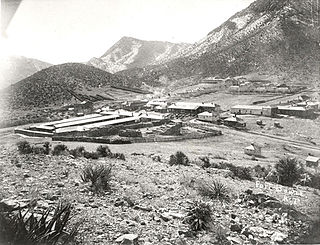
Fort Bowie was a 19th-century outpost of the United States Army located in southeastern Arizona near the present day town of Willcox, Arizona. The remaining buildings and site are now protected as Fort Bowie National Historic Site.
The Alabama Register of Landmarks and Heritage, commonly referred to as the Alabama Register, is an official listing of buildings, sites, structures, objects, and districts deemed worthy of preservation in the U.S. state of Alabama. These properties, which may be of national, state, and local significance, are designated by the Alabama Historical Commission. The designation is honorary and carries no direct restrictions or incentives. The register includes properties such as cemeteries, churches, moved properties, reconstructed properties, and properties at least 40 years old which may not normally qualify for listing in the National Register of Historic Places. There are approximately 1683 properties and districts listed on the Alabama Register. Of these, approximately 238 are also listed on the National Register of Historic Places and 6 are designated as National Historic Landmarks.
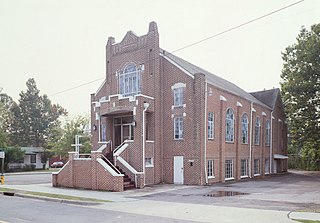
Bethel Baptist Church is a Baptist church in the Collegeville neighborhood of Birmingham, Alabama. The church served as headquarters from 1956 to 1961 for the Alabama Christian Movement for Human Rights (ACMHR), which was led by Fred Shuttlesworth and active in the Birmingham during the Civil Rights Movement. The ACMHR focused on legal and nonviolent direct action against segregated accommodations, transportation, schools and employment discrimination. It played a crucial role in the 1961 Freedom Rides that resulted in federal enforcement of U.S. Supreme Court and Interstate Commerce Commission rulings to desegregate public transportation.

The Pleasant Hill Presbyterian Church, originally known as Mount Carmel Presbyterian Church, is a historic Greek Revival church in Pleasant Hill, Alabama. The current structure was built between 1851 and 1852. It features a distyle-in-antis type portico with simple box columns, a bell tower topped by a small domed cupola, and a second-floor balcony around three sides of the interior. It was placed on the Alabama Register of Landmarks and Heritage on the November 2, 1990 and on the National Register of Historic Places on April 22, 1999.
A Mississippi Landmark is a building officially nominated by the Mississippi Department of Archives and History and approved by each county's chancery clerk. The Mississippi Landmark designation is the highest form of recognition bestowed on properties by the state of Mississippi, and designated properties are protected from changes that may alter the property's historic character. Currently there are 890 designated landmarks in the state. Mississippi Landmarks are spread out between eighty-one of Mississippi's eighty-two counties; only Issaquena County has no such landmarks.

Perdue Hill is an unincorporated community in Monroe County, Alabama. It has one site listed on the Alabama Register of Landmarks and Heritage, the Perdue Hill Masonic Lodge. The home of William B. Travis is located along U.S. Route 84 in Perdue Hill and was moved here in 1985 from Claiborne.
Tunnel Springs is an unincorporated community in Monroe County, Alabama, United States. It has one site listed on the Alabama Register of Landmarks and Heritage, the Old Scotland Presbyterian Church.

Chunchula is an unincorporated community and census-designated place (CDP) in Mobile County, Alabama, United States. As of the 2020 census, its population was 195. It has a post office with the 36521 ZIP code. The community has one site listed on the Alabama Register of Landmarks and Heritage, the Chunchula School.
This is a list of properties on the Alabama Register of Landmarks and Heritage, sorted alphabetically by county. This list contains all entries for Pickens County through Winston County, the other listings may be found here. The Alabama Register of Landmarks and Heritage is an official listing of buildings, sites, structures, objects, and districts deemed worthy of preservation in the U.S. state of Alabama.
This is a list of properties on the Alabama Register of Landmarks and Heritage, sorted alphabetically by county. This list contains all entries for Autauga County through Choctaw County, the other listings may be found here. The Alabama Register of Landmarks and Heritage is an official listing of buildings, sites, structures, objects, and districts deemed worthy of preservation in the U.S. state of Alabama.
This is a list of properties on the Alabama Register of Landmarks and Heritage, sorted alphabetically by county. This list contains all entries for Clarke County through Dallas County, the other listings may be found here. The Alabama Register of Landmarks and Heritage is an official listing of buildings, sites, structures, objects, and districts deemed worthy of preservation in the U.S. state of Alabama.
This is a list of properties on the Alabama Register of Landmarks and Heritage, sorted alphabetically by county. This list contains all entries for Madison County through Perry County, the other listings may be found here. The Alabama Register of Landmarks and Heritage is an official listing of buildings, sites, structures, objects, and districts deemed worthy of preservation in the U.S. state of Alabama.
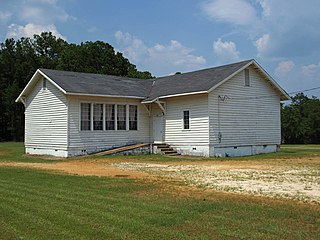
The Mount Sinai School is a historic Rosenwald School in rural Autauga County, Alabama, USA, northwest of Prattville. The one-story frame building was built in 1919 to the designs of W.A. Hazel to serve the local African American community. The money to build it was provided by the Julius Rosenwald Fund. The school was added to the Alabama Register of Landmarks and Heritage on February 2, 2001. It was subsequently listed on the National Register of Historic Places on November 29, 2001, as a part of The Rosenwald School Building Fund and Associated Buildings Multiple Property Submission.
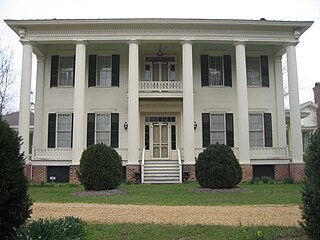
Belvoir, also known as the Saffold Plantation, is a historic plantation house built by Reuben Saffold II near Pleasant Hill, Alabama, United States. The Greek Revival-style house features a Carolina-type, hexastyle portico with Doric columns. It was added to the Alabama Register of Landmarks and Heritage on November 2, 1990.
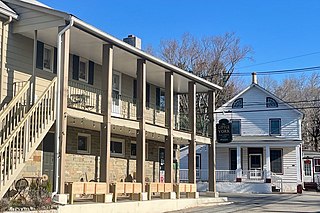
Little York is an unincorporated community located along the border of Alexandria and Holland townships in Hunterdon County, in the U.S. state of New Jersey. Little York is located on County Route 614 3.1 miles (5.0 km) north-northeast of Milford. Little York has a post office with ZIP Code 08834.














